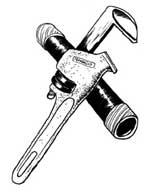|
Caulking - How, When, and Where
Caulking, by definition, is a word used to describe a process used to seal joints and seams. To remove old sealant, a sharpened flathead screwdriver works as well as a putty knife. Be careful not to damage surfaces underneath. A caulking gun and some sealant are practically all you will need. Determining the proper sealant for the job: First and foremost-read the label on the tube to ensure it will stick to the surface you require it to. There is specific indoor and outdoor sealant, some that can withstand extreme temperatures, and some that is mildew resistant. Having the proper materials and tools for the job is vital. Luckily, there aren’t many tools required for this job.Three most common types of sealant are: 1) Acrylic latex/or water-based sealant: This type is used on wet or dry surfaces. It’s commonly found around door and windows. This one can be painted and cleans up easily with soapy water. 2) Silicone sealant: This is the most common type since it remains flexible after drying and is available in a range of colors. It is commonly used around doors and windows also but it cannot be painted. It will not seal if applied onto a damp or wet surface. Dry the surface completely before applying. Laquer thinner can be used for clean up. 3) Kitchen and Bathroom: This sealant is used in high moisture areas where you need to curb the growth of mold and mildew. It can withstand high humidity and plenty of moisture. There is a specific caulk for mortar, and for stone/brick and concrete. Take your time! Test your skills on a scrap piece of material before attempting the real job. Sealent is not expensive but you will want it to resemble a professional job as much as possible. Once you have selected the proper sealant for your job and experimented to improve your results, it is time to get started. You may have already noticed with your practice run that it is very important to get just the right amount of sealant in order to keep waste at a minimum. This is achieved by cutting just the right size hole in the tube of caulking for the job required. Always apply little more sealant than is required to allow for smoothing out. Creating a smooth and consistant seam while joining of two areas together should be your goal. I have found my finger to be the best tool for the job. Latex gloves can be warn to protect your hands but you may find them a nuisance. The palm of your finger has just the right concave curve to achieve the desired results. Masking tape can be used to keep your line straight on each side of the bead of sealant. If the sealant is left as a convex curve you will have problems with dirt and grime in the crevaces it creates. I am told that brick is especially difficult to caulk. You might want to hire a professional for this one or practice a few times on some scrap pieces. Other handy tools for the job: utility knife, putty knife, dry cloth, paper towel, and an abundance of patience. How to unplug a partially used tube of sealant: Gently slice a small piece off the end of the nozzle making the hole slightly larger than the original one. Force a long nail or a screw into the end of the nozzle. Pull the nail or screw out and voila! A screw with course threads, such as drywall or deck screws, will sometimes bring the old and dried sealant out with them allowing clear access to the rest of the sealant. If you have some sealant left over after your job is finished, simply release the pressure on the caulking gun and insert a nail into the opening. Wrap some saran wrap around the entire nozzel and store in a cool place. As with any project allow sufficient time for the caulking to cure to ensure best results.
Return to Family Handyman Questions Home Page from Caulking
|
Family Handyman Quick Links
Looking for a Toronto plumber? Hiring a plumber can effectively fix your plumbing!
Download free Handyman clipart
Download free Handyman Business forms


